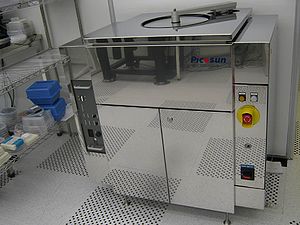Specific Process Knowledge/Thin film deposition/ALD Picosun R200
ALD1
Feedback to this page: click here
This page is written by DTU Nanolab internal
ALD - Atomic layer deposition

The ALD1 (Picosun R200 ALD) tool is used to deposit a very thin layer of Al2O3, TiO2 (amorphous or anatase), and HfO2 on different samples. The layer can be up to 100 nm thick, see the table below.
Each process uses two different precursors. The reaction takes place in cycles. During each cycle, a very short pulse of each precursor is introduced into the ALD reaction chamber in turn. Between each precursor pulse, the chamber is purged with nitrogen. All reactions must take place on the sample surface; therefore, it is crucial that each precursor is removed from the chamber before the next one is introduced. In that way, materials can be deposited atomically, layer by layer, by ALD.
To ensure the ALD reactor maintains a uniform temperature throughout, it features a dual-chamber structure. The inner chamber is the reactor chamber, and the outer chamber is a vacuum chamber that isolates the reactor from room air. The space between the two chambers is referred to as an intermediate space (IMS), which is constantly purged with nitrogen. A sample holder is placed in the reactor chamber.
When the reactor chamber is heated or cooled, it will take some time for the sample holder and the sample to reach the desired temperature. Therefore, it is essential to incorporate a temperature stabilization period into the process recipes.
The ALD deposition takes place in the reactor chamber. All precursor and nitrogen carrier gas lines are connected to the reactor chamber through separate gas lines. The precursor pulse time is controlled using special ALD valves that enable the introduction of very short precursor pulses into the ALD reactor while maintaining a constant nitrogen purge.
The ALD reaction takes place under vacuum; thus, a vacuum pump is connected to the bottom of the ALD reactor chamber. The pump is located in the basement.
The liquid precursors (H2O, TMA, TiCl4, and TEMAHf) are located in the cabinet below the ALD chamber. When these precursors are not in use, the manual valves have to be closed. Only four of the precursors (usually H2O, TMA, TEMAHf, and TiCl4) can be connected at the same time. Ozone is generated using an ozone generator located on the side of the machine.
It is possible to change the sample holder so that ALD deposition can take place on different samples, e.g., a small wafer batch (up to five wafers at a time) or a number of smaller samples. Samples are loaded manually into the sample holder using a tweezer. However, for some materials, the uniformity will only be good for the top sample(s) in a minibatch holder.
A short presentation with some information about the ALD tool can be found here.
The user manual, the user APV and contact information can be found in LabManager:
Process information
Recipes
Process details
- Al2O3 deposition using ALD 1
- TiO2 deposition using ALD 1
- ZnO deposition using ALD 1
- Al-doped ZnO (AZO) deposition using ALD 1
- HfO2 deposition using ALD 1
| Equipment | ALD1 | |
|---|---|---|
| Purpose | ALD (atomic layer deposition) of |
|
| Performance | Deposition rates |
|
| Thickness |
As the purpose of ALD 1 is to deposit very thin and uniform layers, the allowed deposition thickness is limited to 100 nm, and it is not allowed to do more depositions on the same sample(s) to deposit thicker layers than 100 nm. The deposition of thicker layers is not allowed, as this would occupy the machine for an extended period, thereby reducing its availability to fewer users. Long depositions also cause issues, and with flakes and particles, this means that the chamber and the pump line will need to be cleaned or replaced quite often. Furthermore, the delivery time on precursors is usually quite long. When creating a sample design, it is advisable to avoid steps that require depositing thicker layers than 100 nm using ALD. Alternatively, consider whether the same material can be deposited using other machines in the cleanroom. | |
| Process parameter range | Temperature window |
|
| Precursors |
| |
| Substrates | Batch size |
|
| Allowed materials |
| |
